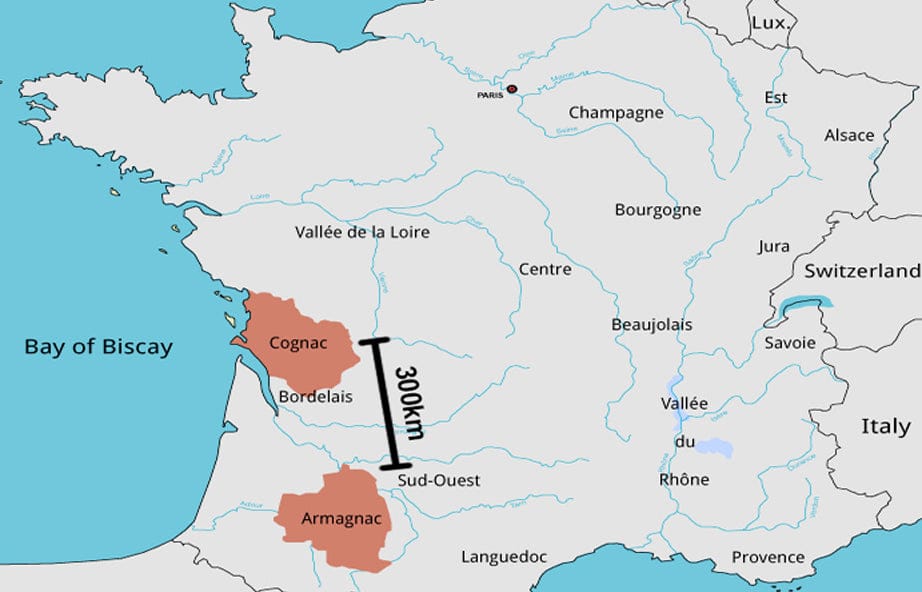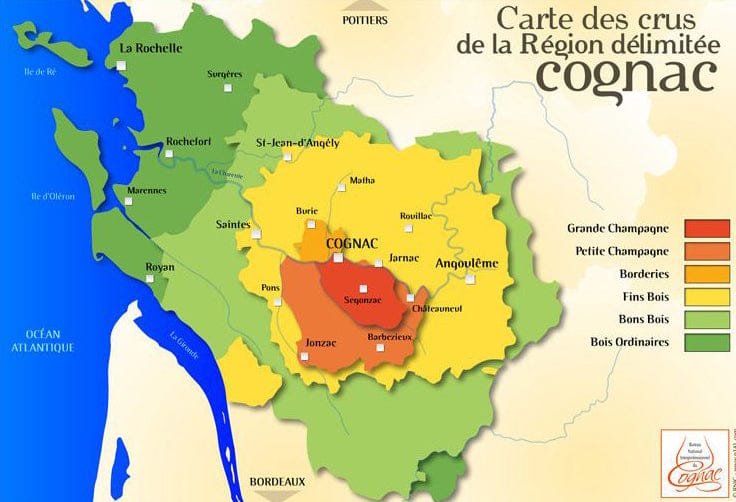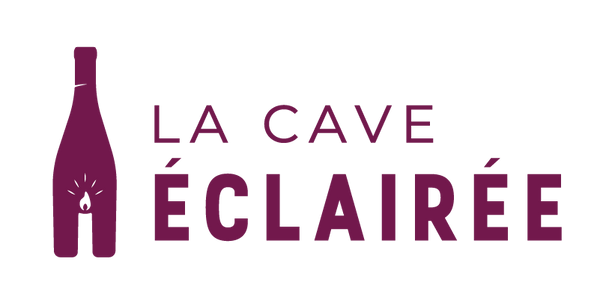Cognac and Armagnac are two French eaux-de-vie aged in oak barrels (with the exception of the White Armagnac ) and from the same raw material, white grapes. However, each of them has its own identity and a very rich centuries-old history.
Here is a summary that will help you better understand the uniqueness of these two spirits.
Location, organization & climate
300 kilometers separate Cognac and Armagnac . Indeed, if the latter is produced in the Southwest from France , THE Cognac is originally from of North of Bordeaux , mainly from the departments of Charente and Charente-Maritime.
This difference in location implies a climate difference : Cognac enjoys a particularly oceanic climate (rather high rainfall, low annual thermal variations) while Armagnac benefits from a more continental area (lower rainfall, greater annual thermal variations ).

From an organizational point of view, The AOC Cognac is divided into 6 crus : Grande Champagne, Petite Champagne, Borderies, Fins Bois, Bons Bois and Bois Ordinaires . The most popular vintages are those located around the town of Cognac: Grande Champagne & Petite Champagne.
The AOC Armagnac is composed of 3 sub-regions: Lower Armagnac, Upper Armagnac and Armagnac Ténarèze.
These distinctions were created due to the slight differences in terroir as well as the quality of the spirits produced. However, be careful not to make too many generalizations, as the quality of the final product depends more on the quality of the vineyard and the know-how of the distiller than on any notion of vintage.


Numerical comparisons
Comparing the Armagnac and Cognac markets is a bit like comparing David and Goliath.
In fact, if the Cognac's wine-growing area is 75,000 hectares , Armagnac only covers 15,000 , 5 times less therefore. Furthermore, the Cognac market represents approximately 3.5 billion euros in turnover for almost 200 million bottles . Compared to these figures, Armagnac seems very small with a artisanal production of 6 million bottles (30 times less) and a turnover of 40 million euros (85 times less). Finally, if Cognac is a market resolutely turned towards export (98% of its volumes), France still represents 50% of the Armagnac market.
However, the differences between these two spirits cannot be summed up as a numerical war. Indeed, each of these spirits has a unique history, a distinct distillation process as well as different terroirs and taste markers.
History of Cognac and Armagnac
Cognac : From the 15th century onwards, thanks to the Charente River, Dutch ships regularly came to stock up on wines from the region. However, the latter did not withstand long sea voyages well.To solve this problem, the Dutch decided to distill these wines. They They first did it in Holland and named the product "brandwijn" (burnt wine) which later gave rise to "brandy" , wine brandy. They will later install stills in Charente, which will allow the product to travel in the form of unalterable brandy.
In the 18th century, the market began to organize itself and it was during this period that most of the major houses were created: Martell (1715), Rémy Martin (1724), Hennessy (1765) etc. 1860, under the impetus of Napoleon III and thanks to the signing of a trade treaty between France and England, Cognac begins a meteoric rise.
Historically, Cognac has always been an export product : first for the Dutch, then for our English friends. Today, its production is still exported to 160 countries, with the United States as its number one customer. Furthermore, unlike Armagnac, Cognac is a very concentrated market: the top 4 trading houses (Martell, Rémy Martin, Hennessy, Courvoisier) represent 90% of the market!
Armagnac : From a historical point of view, Armagnac is older than Cognac . The spirit is also considered to be the oldest in France. thanks to writings dating back to 1310. It was then called "Aygue Ardente" (or simply brandy).
If the The 15th century marked the beginning of its commercialization, and it was in the 18th century that the market boom began. At that time, the Dutch (them again!) went up the Garonne and concluded their first contract with winegrowers from Gers for the purchase of wines. Fearing competition, the Bordeaux people intercepted the convoys going down the river under the pretext that no wine other than Bordeaux could be transported by river. If wine was banned, the spirits are not not, and this is how wines began to be distilled on a large scale in the Gascony region. The Dutch then bought large quantities of Armagnac alcohol to enrich and stabilise the wines they supplied to the peoples of Northern Europe. L' Armagnac then becomes a real commercial product that undergoes the fluctuations of the years, good or bad. To smooth the quality, it will be decided to put the brandy in reserve in wooden barrels. We will then discover the benefits of aging: color, roundness and aromas.
Terroir & grape varieties
THE Cognac soils are known to be very calcareous while the Armagnac terroir is more diverse: mainly sandy , some areas are also clayey-calcareous and clayey-siliceous.
In terms of grape varieties, white ugni represents 98% of Cognac vines . It has a high acidity and a low sugar content corresponding to the criteria sought for distillation. It can be supplemented by other grapes such as Colombard, Folle blanche and a few other very minor ones.
Armagnac has a more varied composition. : if the Ugni blanc is also very present (55%), 9 other grape varieties can be used including in particular the Baco (35%) or even the Crazy White And THE Colombard .This diversity is due to the region's wine tradition which also produces tasting wines while the Cognac region only produces wine for distillation.
Distillation
To obtain a cognac, a double distillation in copper pot stills (called Charentais stills) is mandatory.
While Armagnac can also use this method, distillers in the region use in the vast majority short column stills allowing a single continuous distillation .
We will not go into too many technical considerations here, but it is important to remember that no method can be judged to be more qualitative than the other. Indeed, when it comes to obtaining a quality eau-de-vie, the key elements remain above all the quality of the grape and the know-how of the distiller.
Taste markers & age indications
If markers exist for these two spirits, it can nevertheless be complex for tasters (even professional ones) to distinguish a Cognac from an Armagnac blindly , especially for those that have undergone long aging in oak barrels. So there is no shame if you have ever confused both !
Cognac is generally identified by aromas of raisins or violets . For Armagnac, the prune and floral aromas more pronounced can allow its identification. The older these spirits are, the more they will tend towards common aromatics of candied fruits and orange peel.
Finally, while it is common to produce vintage Armagnacs (bearing the mention of a specific harvest year), this is much less common for Cognac. It should also be noted that each of the eaux-de-vie can bear mentions guaranteeing a number of years of aging:

What to choose ?
If several elements bring Cognac and Armagnac together, Many differences also characterize them, allowing us to enjoy two eaux-de-vie with a unique character and representing French know-how throughout the world.
Some will appreciate perhaps a Cognac XO with a rich and complex aroma. Others will prefer the floral, fiery and perfumed aspect of a young Armagnac. There is only one solution to know what you like: tasting.
For these spirits, The Illuminated Cellar works with two exceptional houses: Guy Lhéraud Cognacs as well as Baron Gaston Legrand Armagnacs .
Do not hesitate to call on our services for advice!










2 comments
Merci pour cet article simple d’accès et très complet !
le dossier sur l’armagnac et le cognac est très instructif.
bravo et merci